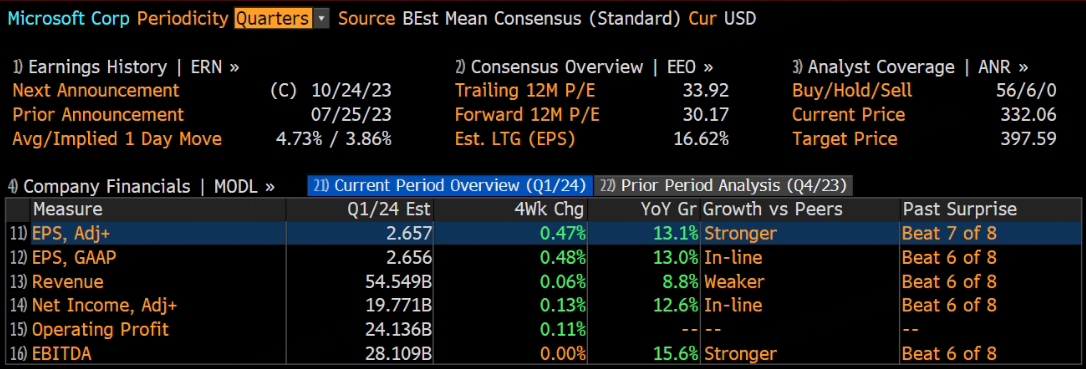Azure's outlook for 2Q will likely be more critical compared to any other KPI when Microsoft reports fiscal 1Q24 results on Oct. 24, amid strong interest in generative AI.
Microsoft will report its Q1 FY24 earnings after the US markets close on 24 October, which will be the morning of 25 October in the Asia-Pacific time zone. The company’s shares fell about 10% after hitting an all-time high in July as the AI frenzy faded. Microsoft has been a front-runner in the AI race since its launch of ChatGPT in February. However, its cloud business, Azure’s revenue growth slowed for the fifth consecutive quarter, according to its last quarterly report. Below are the key aspects of its upcoming earnings results.
Q4 FY23 Review
Microsoft beat market expectations in its Q4 FY23 results, with earnings per share at $2.69 on revenue of $56.19 billion, up 20% and 8% from a year ago, respectively. However, the company provided disappointing guidance for the current quarter as weakened demands in PC continued to pressure the growth. Microsoft forecasted revenue of between $53.8 billion and $654.8 billion for the September quarter, implying an 8% year-on-year growth, missing an estimated $54.94 billion. Its key division, Azura Cloud, rose 26% from a year ago, posting the fifth consecutive month slowdown.
What to expect in Q1
Focusing on Recovery in the Azure
Azure's outlook for 2Q will likely be more critical compared to any other KPI when Microsoft reports fiscal 1Q24 results on Oct. 24, amid strong interest in generative AI. Microsoft has been the most vocal among large software vendors in launching new AI products, given its close relationship with OpenAI, which runs on Azure. Despite this, 2Q Azure estimates are up less than 0.5% since May and consensus calls for sales growth of 25% in constant currency. However, Bloomberg believe that any guidance of less than 28% for the quarter could be met with disappointment.
1Q operating margins and the 2024 outlook will likely be another key metric, given the high cost of hosting generative AI workloads. It is possible that Microsoft cuts more operating expenses such as hiring and travel to offset the drag caused by these higher costs.
Teams, Office 365 to Aid Productivity & Business Growth
The momentum witnessed for Teams, Microsoft’s workspace communication offering, might have acted as a tailwind in the to-be-reported quarter. Teams’ expanding customer base and features have been helping MSFT win shares in the enterprise communication market against Zoom. Teams’ user growth is expected to have been driven by the hybrid/flexible work model.
For the fiscal first quarter, Microsoft expects revenue growth in the Productivity and Business processes segment between 9% and 11% to a range of $18-$18.3 billion. Zacks’s model estimate is pegged at $18.26 billion, indicating growth of 10.9% year over year.
MSFT expanded the availability of Microsoft 365 Copilot to a wider range of customers, which is expected to have boosted revenue growth.
A Silver Lining for the PC Market Even as Decline Continues
Revenues from Windows are likely to have been driven by steady traction seen in Windows Commercial products and cloud services growth amid improving personal computer (PC) demand.
After eight consecutive quarters of year-over-year decline, the PC market is showing initial signs of stabilization, including sequential growth from the previous quarter. Per Gartner report, PC shipments in the July-September 2023 quarter declined 9% year over year to 64.3 million units. The third-quarter PC shipment data shows a strong improvement from the second quarter when PC vendors had shipped 59.7 million units.
For More Personal Computing, the company projects revenues between $12.5 billion and $12.9 billion, pressured by the persistent decline in the personal computer market. It expects Windows OEM revenues to decline in the low-to-mid teens range.
Zacks’s model estimate is pegged at $12.69 billion, indicating a decline of 4.7% from the figure reported in the year-ago quarter.
Microsoft’s development in Azure OpenAI Service
Since the announcement of a $10 billion investment into ChatGPT, Microsoft has thrived in AI development in the cloud business Azure. The company announced that ChatGPT was available in preview in Azure OpenAI Service in early March and expanded its service to wider applications and regions in the past 6 months. The prominent progress was an announcement of the Microsoft 365 Copilot, which is its artificial intelligence supplement to the core software such as Word and Excel. Office makes up approximately 24% of the tech giant’s revenue and grew 16% year on year in the June quarter. Hence, Azure and other cloud services, together with Office 365 Commercial revenue, will be the key focused sections in the upcoming earnings report. Microsoft’s CFO, Amy Hood, said that growth from AI services would be gradual and the financial effect would mainly show in the second half of the fiscal year 2024, which is the first half of calendar year 2025.
Microsoft’s takeover of Activision Blizzard
Microsoft has finally completed the $69 billion takeover of Activision Blizzard recently. The industry’s biggest-ever deal may consolidate Microsoft’s top market share in the gaming empire as the tech giant gained control over games such as Call of Duty, World of Warcraft, Candy Crush, etc. However, gaming revenue only accounts for about 6% of Microsoft’s overall revenue, and the benefit of the deal will not show in the upcoming earnings report.
Q1 FY24 Forecast by Bloomberg
Earnings Per Share: $2.657, +13.1% year on year
Revenue: $54.55 billion, +8.8%
Net Income: $19.77 billion, +12.6%

Comments